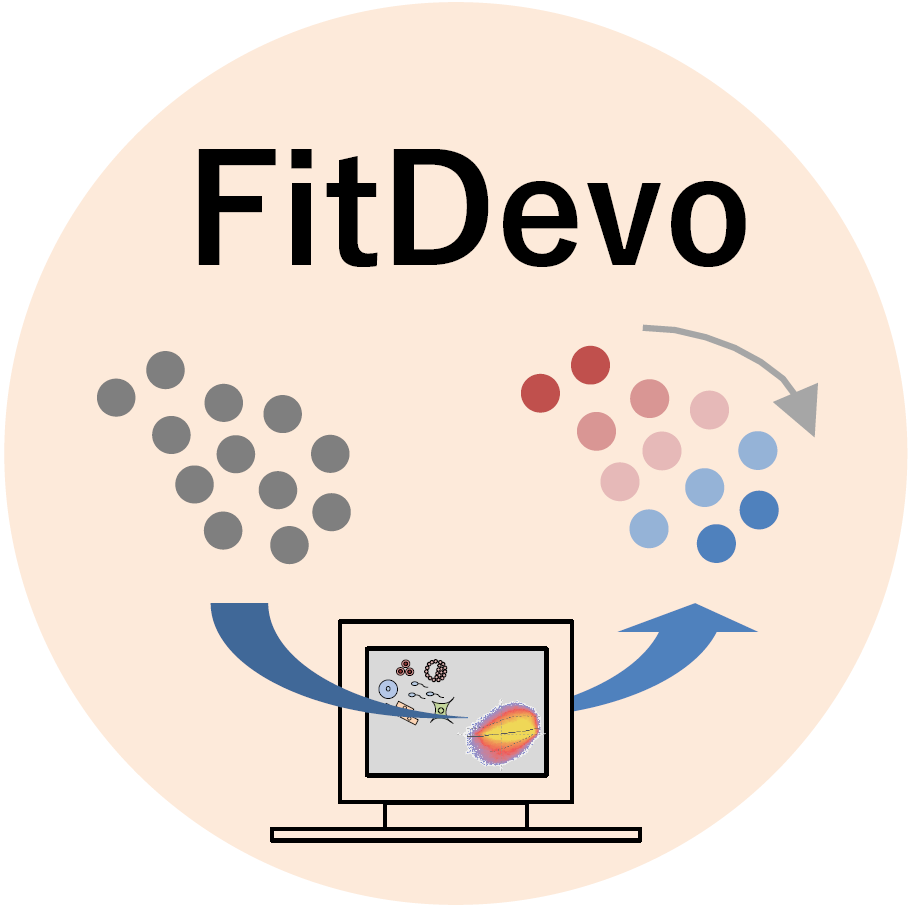FitDevo: accurate inference of single-cell developmental potential using sample-specific gene weight, Briefings in Bioinformatics, 2022
Paper Link: https://doi.org/10.1093/bib/bbac293 | Supplementary Files
This tool is designed for inferring the developmental potential (DP) of cells in scRNA-seq data
2022.07.13, v1.2.0 - Higher speed! Improve the computational efficiency by using "qlcMatrix".
2022.07.01, v1.1.0 - New features! Users can use "fitdevo.field" to build developmental potential field (DPF) and draw arrows.
2022.06.30, v1.0.1 - Paper version. The details of this version is described in our BIB (2022) paper.
- Demo 1 - Infer developmental potential (DP) using expression matrix of scRNA-seq data
- Demo 2 - Build developmental potential field (DPF) and draw arrows
Training dataset (n=17), https://sourceforge.net/projects/fitdevo/files/training/
Testing dataset (n=28), https://sourceforge.net/projects/fitdevo/files/testing/
Each sample is saved in a "RDS" file.
Users can use R to load the "RDS" file.
# R code
data1 = readRDS('1.rds')
# data1$mat is the expression matrix
# data1$tag is the reverse order of timepoint label (higher value indicates higher developmental potential).
R: 4.0.0+
Seurat: v4 (the original fitdevo is developed with Seurat v4)
qlcMatrix: 0.9.7
FitDevo for Seurat v5: https://github.com/jumphone/FitDevo/blob/main/fitdevo_seurat5.R
Seurat: https://satijalab.org/seurat/articles/install.html
qlcMatrix: https://cran.r-project.org/web/packages/qlcMatrix/index.html
install.packages("qlcMatrix")
Seurat v4:
remotes::install_version("SeuratObject", "4.1.4", repos = c("https://satijalab.r-universe.dev", getOption("repos")))
remotes::install_version("Seurat", "4.4.0", repos = c("https://satijalab.r-universe.dev", getOption("repos")))
Seurat v5:
install.packages("Seurat")
source('https://github.com/jumphone/FitDevo/blob/main/fitdevo.R?raw=true')
# source('https://github.com/jumphone/FitDevo/blob/main/fitdevo_seurat5.R?raw=true')
fitdevo( MAT=MAT, BGW=BGW, NORM=TRUE, PCNUM=50 )
The input of FitDevo includes two files: a BGW list and an expression matrix. The BGW list is provided by us, while the expression matrix is provided by users (should not be scaled). The row and column names of the expression matrix are genes and cell names, respectively. FitDevo can help users to normalize the raw read count by setting the “NORM” parameter to “TRUE”, or users can use “LogNormalize” function in Seurat to conduct normalization. The output of FitDevo is a vector containing the inferred DP of all cells.
MAT: expression matrix
BGW: binarized gene weight (BGW)
BGW=readRDS(url('https://github.com/jumphone/FitDevo/blob/main/BGW.rds?raw=true'))
NORM: whether to conduct normalization
PCNUM: number of PCs used to calculate sample-specific gene weight (SSGW)
A vector of inferred DP
# R 4.0.3
# Step 1. Load FitDevo
source('https://github.com/jumphone/FitDevo/blob/main/fitdevo.R?raw=true')
# Step 2. Load data (the 1st sample in the testing dataset)
data1 = readRDS('1.rds')
MAT=data1$mat
CorrectDP=data1$tag
# Step 3. Load BGW
BGW=readRDS(url('https://github.com/jumphone/FitDevo/blob/main/BGW.rds?raw=true'))
# Step 4. Run FitDevo
DP=fitdevo(MAT=MAT, BGW=BGW, NORM=TRUE, PCNUM=50)
# Step 5. Evaluate the performance of FitDevo
cor(DP, CorrectDP, method='spearman') # 0.7980606
install.packages('igraph')
install.packages('stringr')
Users should provide the embedding coordinates (e.g. tSNE, UMAP, PAGA, etc.). This demo is based on a "seurat.object" with a normalized expression matrix and an UMAP. To generate seurat.object, please refer to: https://satijalab.org/seurat/articles/pbmc3k_tutorial.html
The function named "fitdevo.field" partially follows the idea of another tool named VECTOR. If you are using this function in your work, please also cite: Unsupervised Inference of Developmental Directions for Single Cells Using VECTOR, Cell Reports, 2020. {code, paper}
source('https://github.com/jumphone/FitDevo/blob/main/fitdevo.R?raw=true')
# Step 1. Prepare input files.
MAT=as.matrix(seurat.object[['RNA']]@data)
VEC=seurat.object@[email protected]
BGW=readRDS(url('https://github.com/jumphone/FitDevo/blob/main/BGW.rds?raw=true'))
# Step 2. Infer developmental potential
DP=fitdevo(MAT, BGW, NORM=FALSE, PCNUM=50)
# Step 3. Build developmental potential field (DPF) and draw arrows
FIELD=fitdevo.field(DP=DP, VEC=VEC, SHOW=TRUE)
# Coler scale
plot(x=FIELD$VALUE,y=rep(1,length(FIELD$VALUE)),col=FIELD$POINT.COL,type='h',lwd=2,ylim=c(0,1))
This figure is generated by using the scRNA-seq data of mouse dentate gyrus (PMID: 29335606).



